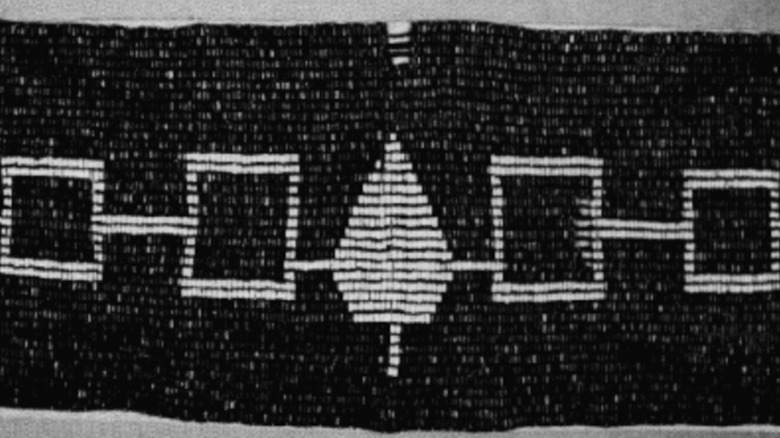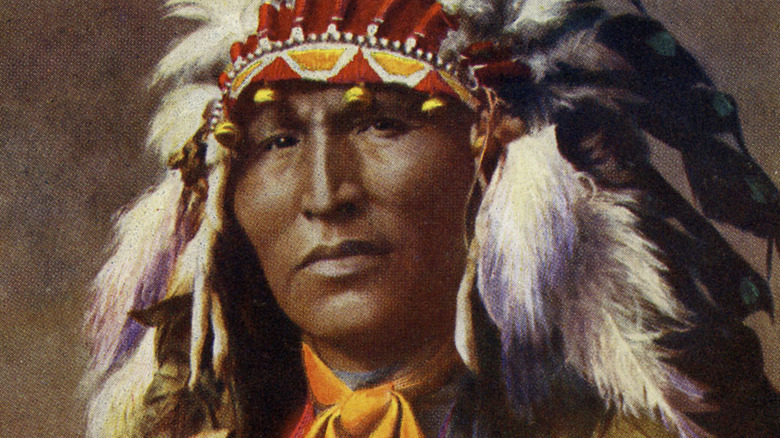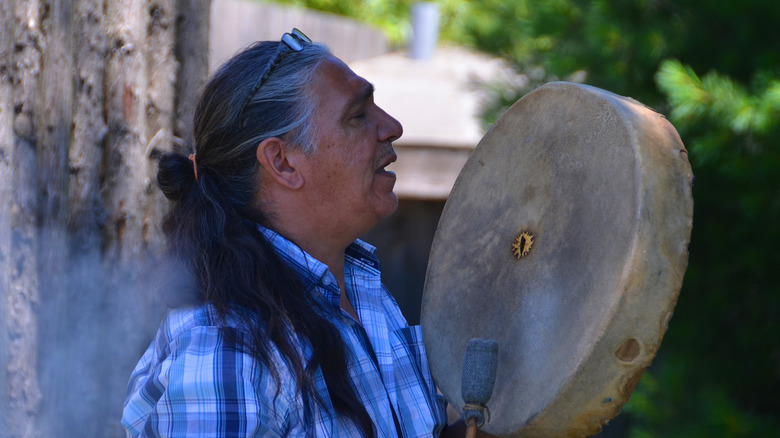What Are The Five Nations That Make Up The Hiawatha Belt?
For centuries, some Indigenous nations in the American northeast used wampum, belts of long shell beads, for a variety of symbolic and ceremonial purposes. The designs marked treaties between tribes, honored great people or events, recorded the law, and more (via the Museum of Ontario). Shells (quahog and white welk) were gathered from the Atlantic coast, ground into beads, and woven into cloth or strung together in a long and arduous process. For societies without writing systems, this was an important method of communication and historical documentation.
One of the most famous wampum is called the Hiawatha Belt. It is the national belt (similar to a flag) of the Haudenosaunee (called the Iroquois by the French), a confederacy of tribes located around and south of the Great Lakes. The Haudenosaunee Confederacy likely began in the 16th century, though there is much debate over this. The belt features four white squares connected to a central white tree, against a purple background (via Onandaga Nation). The powerful story behind what these images represent, though somewhat shrouded in legend, is one of strife and reconciliation.
The End of a Long War
The Hiawatha Belt commemorates and symbolizes five warring nations that made peace and formed the Haudenosaunee: the Seneca, Cayuga, Onondaga, Oneida, and Mohawk. This is the left-to-right order of the symbols, with the Onondaga represented by the tree in the middle (via Onandaga Nation). It was in this nation that all parties buried weapons beneath a Tree of Peace. The Seneca were the westernmost tribe, with the Mohawk forming the eastern border, represented by their positions on the wampum. Later, around 1722, the Tuscarora became the sixth nation of the confederacy, according to History. The belt was not modified to include them.
The wampum also represents the Great Law of Peace, the philosophy of the new Haudenosaunee. It's a decree that people must "use their minds instead of violence to settle their problems," explained John Mohawk of the State University of New York at Buffalo (via PBS). "So it is really aimed at passions. It's aimed at hatreds, and it constructed a very elaborate culture based on negotiations and on the principle of coming together to solve problems using your mind and not your weapons." The belt's meaning, then, included tribal unity, a great historical event, and moral law.
While the original belt fell into the possession of New York State in 1900, it was returned to the Haudenosaunee, after much Native American activism, in 1989 (via Indian Country Today).
The Haudenosaunee and Hiawatha Belt Today
The Haudenosaunee today have the Hiawatha Belt present at every Grand Council, attended by the hoyane, the chiefs, of the Seneca, Cayuga, Onondaga, Oneida, Mohawk, and Tuscarora (via Onandaga Nation). The council continues the work of "The Great Peacemaker" Deganawida, a Huron prophet, and Hiawatha, an Onondaga chief, the founders of the confederacy (via History). Working together to do what is best for all the tribes is paramount.
Based in Ontario, the council and its departments and institutes oversee Haudenosaunee land, address land reacquisition and disputes in courts, work for environmental conservation, preserve their culture and document history, and more (via Haudenosaunee Confederacy). Tribal lands dot Canada and the U.S. around Lake Erie and Lake Ontario (via Native Land Digital).
Additional meaning has come to surround the sacred artifact that marked an end to war between five tribes. Today the Hiawatha Belt, according to the Oneida Cultural Heritage Department, is considered one of the most important and valuable wampum on Earth.


